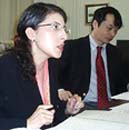Platform Seminar at Waseda University:
June Meeting Report
Takahiro MIYAO (Professor and Head, Japanese Institute of Global Communications, International University of Japan)
| Seminar Summary
|
| [Platform Seminar] :June Meeting |
| Date/Time: | June 13 (T) 16:00 - 18:00 |
| Place: | Waseda University R&D (Kenkyu-kaihatsu) Center |
| Program: |
Part 1: 16:00 - 17:00
Speaker: Nathalie Cavasin (Visiting Researcher, Global Information and Telecommunication Institute, Waseda University)
Topic: "Innovation in Optical Lenses: How Japanese Makers of Digital Cameras and Mobile Camera Phones Are Facing Global Competition"
Language: English
Part 2: 17:00 - 18:00
Speaker: Shingo Hamada (Affiliated Fellow, Science and Technology Foresight Center, National Institute of Science and Technology Policy, Ministry of Education, Sports, Culture, Science and Technology, Japan)
Topic: "The Science Communication Project in Japan"
Language: Japanese
|
 The June meeting of the Platform seminar was held at Waseda's R&D (Kenkyu-kaihatsu) Center on June 13, 2006. The main subject was "Japan's Science and Technology," and two researchers who have been collaborating with each other on this subject made their presentations separately. The following is a summary of the seminar presentations. The June meeting of the Platform seminar was held at Waseda's R&D (Kenkyu-kaihatsu) Center on June 13, 2006. The main subject was "Japan's Science and Technology," and two researchers who have been collaborating with each other on this subject made their presentations separately. The following is a summary of the seminar presentations.
Part 1: Innovation in Optical Lenses: How Japanese Makers of Digital Cameras and Mobile Camera Phones Are Facing Global Competition
The outline of Dr. Nathalie Cavasin's presentation is as follows: (1) Background for the Research Project, (2) Evolution of Digital Still Camera, (3) Mutations of the Industry and the Position of Japanese Corporations, (4) Disruptive Technology: Case Study of Varioptic in France, and (5) Ecosystem of Digital Imaging: First Interpretation. According to Dr. Cavasin, this study was initiated by NISTEP (National Institute of Science and Technology Policy) and then transferred to her in March 2006.
The main point of her presentation is as follows. Despite the rapid evolution of digital camera business in the U.S., Japan and Asia in recent years, there have not been many innovative developments in the digital camera system in the past. However, we can find an interesting case of a French university-based start-up, Varioptic, using a new type of liquid lenses, which may be regarded as a disruptive technology to challenge the current state of lenses used in digital cameras. Why in France, and not in Japan? A lesson for Japan is to foster an effective network of university-industry-government collaboration for creativity and innovation in Japan. This is needed to develop a successful business model in this field to be based on a system of "digital imaging" with competitive technology, such as liquid lenses, in the next-generation ubiquitous network society.
Part 2: The Science Communication Project in Japan
In his presentation, Mr. Shingo Hamada first explained some background for his idea based on various developments on global issues in science, technology and society, where he referred to the formation of COEs (Centers of Excellence) in Science Communication at such universities as Tokyo, Waseda, Tohoku, Osaka, etc. as well as the so-called "Science Café," supported by MEXT (Ministry of Education, Sports, Culture, Science and Technology) in 2005, which was considered "year one for science communication in Japan." Then he outlined his proposal for a new type of science communication program to focus on social studies on science and technology to help integrate (1) science and technology journalism, (2) science education, and (3) popularization of science and technology, by learning from recent developments in this field in Europe, Asia and North America. Mr. Hamada emphasized the importance of a "problem-solving" approach to global issues by integrating social, scientific and technological knowledge and experience for the purpose of finding characteristic structures for various social problems from the scientific and policy viewpoints
The table of contents for his proposed program is as follows: (I) Necessity of STS (Science, Technology and Society)-based Research on Science Communication, (II) Researcher Training in Science Communication, (III) Science and Media - New Communication Tools for Sharing Creativity, (IV) Laboratory Studies on Technology Shaping, and (V) Ready for Town Meeting! (http://scicom.jp/English/)
|





